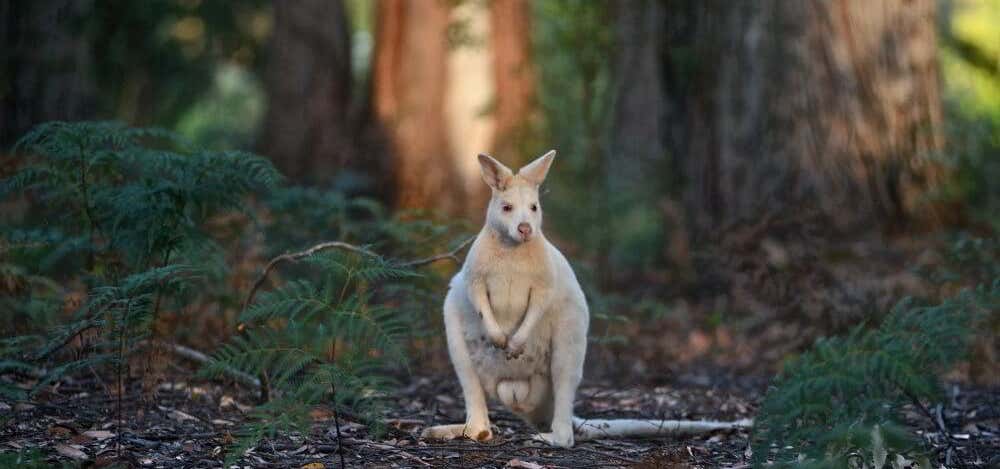Once considered Australia’s forgotten state, Tasmanian has switched its reputation around, merging its rich history with a burgeoning food scene, stunning natural sights, and enticing wildlife.
With the whole island teeming with fauna thanks to a lack of predators, almost the whole island becomes a wildlife spotting adventure. Tasmania is also a prime destination for ticking the pademelon off your Aussie animal checklist. This thickset member of the wallaby family is extinct on mainland Australia so a trip to Tasmania is the only chance you’ll get to see one! And make sure you check out the Unzoo below for your chance to see the Tasmanian Devil on their turf, and their terms.
1
Adventure Bay
Wallabies are those adorable marsupials that live in the shadow of the kangaroo. There are wallabies… and then there are white wallabies. These rare albino creatures are native to Bruny Island, off the southeast coast of Tasmania.
Like many of us, the midday sun is not suited to their colouring so expect to see one of the 200 snow-white wallabies around dawn or dusk on the south side of Adventure Bay. You’ll also find little penguins on Bruny Island from September to February, as well as possums, echidnas, and pademelons.
Rent a car to explore Bruny Island as it’s only a 15-minute ferry ride from the mainland.
2
Bonorong Wildlife Sanctuary
The team at Bonorong have a mission to inspire and educate with their wildlife reserve, located thirty minutes north of Hobart. This broad pastureland is sanctuary to orphaned, injured or ill Australian animals and birds, with all entry fees funding their rehabilitation and conservation efforts.
There are three free daily tours, with a focus on the Tasmanian devil, as well as a chance to get up-close-and-personal with wombats and koalas. A complimentary bag of kangaroo food ensures these freely roaming marsupials are keen for a meet and greet with you. A range of animal encounters is also on offer, including a fascinating 2.5-hour night tour.
3
Tasmanian Devil Unzoo
Located in the Tasmania Peninsula is the world’s first unzoo. What on earth is an unzoo? It’s a brilliant concept to describe their four-in-one nature experience where wildlife adventures, animal encounters, native gardens and Tasmanian art are found across their large botanical garden. It’s the perfect introduction to all that makes this state special.
Wallabies, kangaroos, pademelons, quolls and more are on offer within the animal section of the unzoo, as well as Tasmania’s only bird show.
Visiting the Unzoo has a feel-good factor thrown in as the entrance fees, while a little higher than most, go towards conservation efforts.
Maria Island National Park
The unspoiled treasure of Maria Island, with its craggy cliffs, pristine beaches, and historical ruins are a drawcard alone but add to that the copious wildlife opportunities and you have hit the travel bullseye.
This island national park is only 30-minutes by ferry from Triabunna and the lack of vehicles on Maria Island makes it a haven for the usual native Tasmanian animals that call it home. Maria Island has a reputation as a bird watchers paradise and if you’re exploring along the coast, watch out for passing dolphins, whales and seals. We note to scuba divers - Maira Island is a must do, so make time to plunge into the marine-life-rich waters if you can.
4
Bicheno Penguin Tours
Great penguins come in small packages and in Tasmania you can see the world’s smallest penguins at Bicheno on the east coast. Called little or fairy penguins, these adorable seabirds spend 80% of their time in the ocean so you’ll need to wait until after sunset to catch them waddling out of the water.
While you can go penguin spotting solo, a lot of the good places to view are on private land. Consequently a tour gives you optimum chances to sight penguins as well as keeping you from spooking the little fellas.
It’s not all about the penguins – while you’re in the area, a trip to Nature World is worthwhile to visit the park’s native mammals, birds, and reptiles.
Flinders Island
As with any good social media star, Derek the baby wombat pulls a crowd. This viral joey has been drawing attention to the tiny isle of Flinders Island, off the northeast coast of Tasmania. At only 1,000 hectares, Flinders Island has a surprisingly large wildlife population, including long-nosed potoroo (rat-kangaroo family), red-necked wallabies, pademelons and, of course, wombats. Snorkel, dive or head out on a boat to spot dolphins, fish, and seals.
A brilliant excuse to soak in the magnificent coastline from the sky, Flinders Island is best accessed by plane from Hobart (35 minutes) and Melbourne (1 hour). Alternatively, take your car on the weekly barge from Bridport.
5
Pepper Bush Adventures
There is something cool about saying you’re going on Quoll Patrol; heading out into the wilderness at dusk to spy these squirrel-sized furry creatures. It’s the ultimate nighttime adventure with Pepper Bush Adventures. On tour, you’ll unearth all of Tasmania’s natural secrets from knowledgeable guide Bushie, as well as enjoying a bushtucker campfire dinner, with local beers and wine. Witness the forest come alive as quolls are joined by the usual native Australian animals.
Pepper Bush Adventures offers a range of tours exploring Tasmania’s finest native habitats and, while they don’t come cheap, their flair for local fauna and expertise make this a trip to remember.
6
Cradle Mountain
If you’re the outdoorsy type then Cradle Mountain is a Tasmanian ‘to-do’. Located in the northeast corner of the state, it’s a two-for-one location with dramatic mountains, alpine heaths and ancient rainforests creating a home for an abundance of wildlife.
Cradle Mountain has a range of trails, from short walks to the epic 6-day Overland Track so plenty of opportunity for native fauna to cross your path. Stay alert to wild wombats, wallabies, pademelons, echidnas, platypus and Tasmanian devil on your route and keep your eyes up to spot some of the 78 species of birds found within the area.
7
Warrawee Forest Reserve
Latrobe is the self-proclaimed ‘platypus capital of the world’. This river town has been spent 25 years preserving the habitat for this egg-laying mammal. Three brothers created the Warrawee Reserve, resplendent with walkways, lake and platypus viewing facilities.
Glimpse the wild platypus either early morning or late afternoon. Entry is free but better still, choose the $10 guided tour with all proceeds going towards their conservation efforts.
8
Narawntapu National Park
Known as the ‘Serengeti’ of Australia, Narawntapu has a low-key tourism profile considering the rich variety of wildlife found within its confines. With a coastal location in Tasmania’s north west, Narawntapu is considered wombat heaven. You also have a high chance of spying wallabies, potoroos, pademelons, kangaroos, reptiles and many fabulous bird species in the wetland area.
Head to the Springlawn area of the park in the evening where the grassland attracts grazing animals. But don’t skip the pristine sands of Baker’s Beach as more native animals chill here too, including the noisy Tasmanian devil.
Explore More Trip Guides
Western Australia’s Wonderful Wildlife
- 9 Places
- 39:16
- 2,160 mi
Whales, Wonderous Whales. And where to see them Queensland.
- 7 Places
- 25:42
- 1,256 mi
Whales, Wonderous Whales. And where to see them NSW.
- 12 Places
- 18:15
- 926 mi
Queensland And Its Glorious Native Wildlife!
- 12 Places
- 26:35
- 1,344 mi












